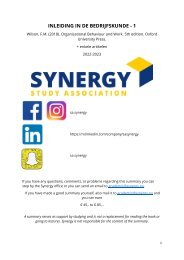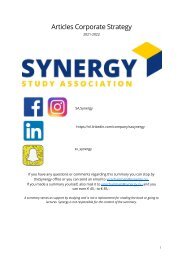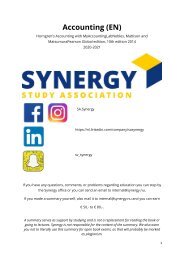Create successful ePaper yourself
Turn your PDF publications into a flip-book with our unique Google optimized e-Paper software.
expansion.<br />
4. To smooth out dividend payments from year to year by accumulating earnings in good years<br />
<strong>and</strong> using such accumulated earnings as a basis for dividends in bad years.<br />
5. To build up a cushion or buffer against possible losses or errors in the calculation of profits.<br />
Before declaring a dividend, management must consider availability of funds to pay the dividend.<br />
Dividends are of the following types:<br />
1. Cash dividends → The board of directors votes on the declaration of cash dividends. Upon<br />
approval of the resolution, the board declares a dividend. A declared cash dividend is a liability.<br />
Because payment is generally required very soon, it is usually a current liability. Companies do<br />
not declare or pay cash dividends on treasury shares.<br />
2. Property dividends → Dividends payable in assets of the corporation other than cash are called<br />
property dividends or dividends in kind. Property dividends may be merch<strong>and</strong>ise, real estate, or<br />
investments, or whatever form of the board of directors designates. When declaring a property<br />
dividend, the corporation should restate at fair value the property it will distribute, recognizing<br />
any gain or loss as the difference between the property’s fair value <strong>and</strong> carrying value at date of<br />
declaration.<br />
3. Liquidating dividends → Some corporations use amounts paid in by shareholders as a basis for<br />
dividends. Dividends based on other than retained earnings are sometimes described as<br />
liquidating dividends. This term implies that such dividends are a return of the shareholder’s<br />
investment rather than of profits. In other words, any dividend not based on earnings reduces<br />
amounts paid-in by shareholders <strong>and</strong> to that extent, it is a liquidating dividend.<br />
4. Share dividends → Companies sometimes issue a share dividend. In this case, the company<br />
distributes no assets. A share dividend therefore is the issuance by a corporation of its own<br />
shares to its shareholders on a pro rata basis, without receiving any consideration. In recording a<br />
share dividend, some believe that the company should transfer the par value of the shares<br />
issued as a dividend form retained earnings to share capital.<br />
To reduce the market price of each share, companies use the common device of a share split.<br />
A share split increases the number of shares outst<strong>and</strong>ing <strong>and</strong> decreases the par or stated value<br />
per share. A share dividend, although it increases the number of shares outst<strong>and</strong>ing, does not<br />
decrease the par value; thus, it increases the total par value of outst<strong>and</strong>ing shares.<br />
Companies are also required to present a statement of changes in equity. The statement of<br />
changes in equity includes the following:<br />
1. Total comprehensive income for the period<br />
2. For each component of equity, the effects of retrospective application or retrospective<br />
restatement<br />
3. For each component of equity, a reconciliation between the carrying amount at the beginning<br />
<strong>and</strong> the end of the period, separately disclosing changes resulting from:<br />
(a) Profit or loss;<br />
(b) Each item of other comprehensive income; <strong>and</strong><br />
(c) Transactions with owners in their capacity as owners, showing separately contributions by <strong>and</strong><br />
distributions to owners <strong>and</strong> changes in ownership interests in subsidiaries that do not result in a<br />
loss of control.<br />
Analysts use equity ratios to evaluate a company’s profitability <strong>and</strong> long-term solvency.<br />
The return on ordinary share equity measures profitability from the ordinary shareholders’<br />
viewpoint. This ratio shows how many dollars of net income the company earned for each dollar<br />
invested by the owners. Return on equity equals net income less preference dividends, divided<br />
by average ordinary shareholders’ equity. Trading on the equity describes the practice of using<br />
36
















